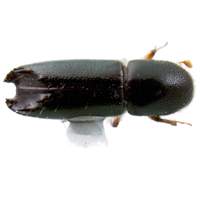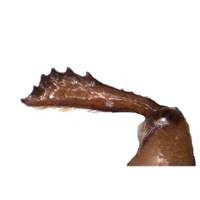Diagnosis
Elytral declivity usually impressed and emarginate. Sides of declivity with elevated sulcus, the sulcus carries spines. In some species, declivity is flat, but all species have at least slightly elevated declivital margins surrounded by tubercles or teeth, and first interstriae broadened to the extent that strial punctures are displaced lateraly.
Distribution
Common throughout South Asia to the far reaches of the Pacific. Rare outside of tropics, absent in the New World.
Biology
Galleries of most species consist of irregularly branching tunnels and several irregular brood chambers. Usually colonizing bottom or the most humid parts of dead trees. Significant portion of the tunnel system often created in phloem-xylem boundary.
Taxonomy
Genus described in Hulcr & Cognato (2010). The name Debus was inspired by the initials of Donald E. Bright, one of the most accomplished contemporary scolytine taxonomist.
Detailed description
Eyes shallowly emarginate, upper part smaller than lower part. Antennal club approximately circular, club type two (obliquely truncated, segment 2 visible on posterior side). Segment 1 prominent, covering most of anterior and nearly all posterior side, its margin concave, fully costate. Segment 2 visible on both sides of club, soft and pubescent, or partly corneous on anterior side. Segment 3 partly visible on posterior side of club. Segment 1 of antennal funicle shorter than pedicel, funicle 4-segmented, scapus regularly thick. Frons above epistoma rugged, coarsely punctate. Submentum slightly impressed, shaped as distinct large triangle. Anterior edge of pronotum with no conspicuous row of serrations (serrations no different than on pronotal slope). Pronotum from lateral view with distinctly elongated disc (type 8), from dorsal view basic shape with rounded frontal margin (type 7), or long, rounded anteriad (type 9). Pronotal disc shining or smoothly alutaceous, with small punctures, lateral edge of pronotum concave (pronotum very long), or obliquely costate. Procoxae contiguous, prosternal posterocoxal process large and inflated. Tuft on pronotal basis associated with mesonotal mycangium absent, setae on elytral bases associated with elytral mycangium absent. Scutellum flat, flush with elytra. Elytral bases straight, with oblique edge, elytral disc longer than declivity, flat, punctures on elytral disc in strial lines. Elytral declivity with few setae, not conspicuously pubescent. Elytral declivity usually excavated and emarginate, surrounded by elevated sulcus, first interstriae broadened to displace strial punctures laterally, declivity surrounded by tubercles or teeth. Posterolateral declivital costa ending in 7th interstriae, or reaching beyond 7th interstriae and encircling most or all of declivity. First interstriae broadened parallel on disc but broadened towards apex of elytra. Protibiae distinctly triangular, slender on upper part, broad and denticulate on lower part. Posterior side of protibia flat, no granules, only setae. Protibial denticles small in small species, but mostly large, distinctly longer than wide. Bases of denticles not enlarged in small species, slightly enlarged in most species, fewer than 6 protibial denticles present. Metatibiae of normal size. Body length 1.8 to 4.2 mm, mostly slender species, never very robust. Light brown to black, pronotum sometimes much lighter than elytra.






